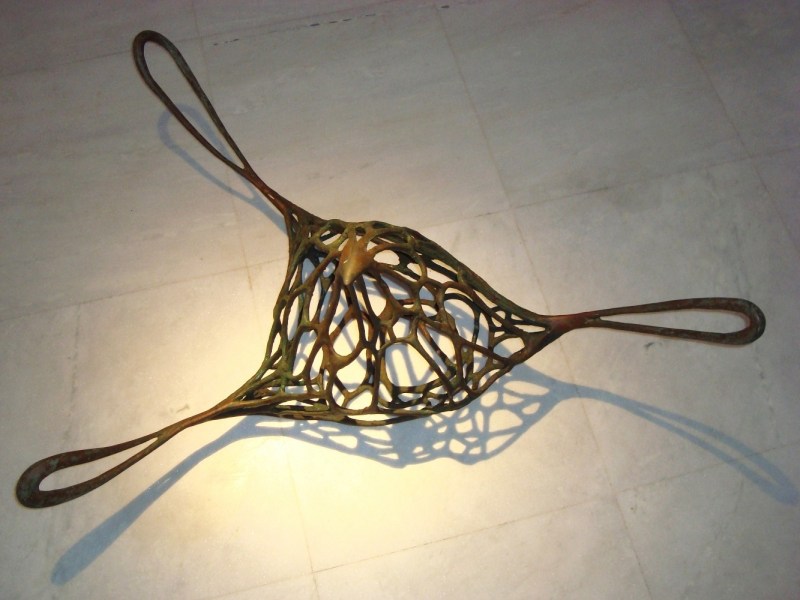
"Ranjani Shettar, who lives and works here in the state of Karnataka, creates ethereal sculptures and installations that really marry the organic to the industrial, and brings, like Subodh (Gupta), the local-global," explained art collector and investment manager Ravin Agrawal at the TED conference in Mysore last year.
Agrawal was speaking about '10 young Indian artists to watch and his list included the names of Bharti Kher, Alwar Balasubramaniam, Chitra Ganesh, Jitish Kallat, N S Harsha, Dhruvi Acharya, Raqib Shaw, Raqs Media Collective, Subodh Gupta, and Shettar.
Projecting images of Shettar's works, Agrawal elaborated, " These are actually wires wrapped in muslin and steeped in vegetable dye. And she arranges them so that the viewer actually has to navigate through the space and interact with the objects. And light and shadow are a very important part of her work. She also explores themes of consumerism, and the environment, such as in this work (shown on a slide), where these basket-like objects look organic and woven, and are (in fact) woven, but with the strips of steel, salvaged from cars that she found in a Bangalore junkyard."
Born in Bangalore (1977) and educated at the Karnataka Chitrakala Parishat (2000-2005). Ranjani Shettar is among the highly sought out Indian artists in international circuits.
Besides Talwar Gallery (Delhi/New York), Shettar's solo shows have been held at the Modern Art Museum, Fort Worth, Texas, US (2008-09); Institute of Contemporary art, Boston, (2008), and San Francisco Museum of Modern Art (SfMoma), San Francisco (2009).
Her installations have been included in a number of exhibitions, such as On Line: Drawing Through the 20th Century, the Museum of Modern Art New York (2011); Liverpool Biennial, UK (2010); Life On Mars, 55th Carnegie International, Carnegie Museum of Art, Pittsburgh (2008); 9th Lyon Biennial, France (2007); 8th Sharjah Biennial, Sharjah (2007); and 15th Sydney Bienniale, Australia.
In 2006, Shettar was an artist-in-residence at Artspace in San Antonio, Texas. In 2005, her works were on view at Fondation Cartier pour l'art Contemporain, Paris, France; Wexner Center for the Arts, Minneapolis, US; and Contemporary Art Museum, Houston, Texas and in 2003, at the Walker Art Center, Minneapolis.
Her forthcoming shows are scheduled to be held at the Fondation d'enterprise Hermes, Singapore and the National Gallery of Victoria, Melbourne, Australia.
The most distinguishing part of Shettar's art practice is her choice and employment of a wide range of man-made and natural material including fibre, cotton, wax, wood, cloth, wire, and steel. "I am open to using any sort of materials," she says. "I use materials that can convey and add to my idea. Every material has uses and associations that are particular to each one of them and so they bring in their own meaning into the works."
Shettar is open to diverse motivations sparked by life and nature. Often, the idea dictates a suitable process and material to work with; at other times, the feel and features of a material trigger her imagination. Most of her works take a very long time to develop. "From an idea to a tangible sculpture is a long journey, sometimes very labor-intensive. I like that process because I can drown myself in the work.
Shettar's works have been described as calligraphic curves in flight; and as open, hovering articulations - at once abstract and evocative of natural forms.
Her use of unconventional material and employment of both modern technologies and traditional craft techniques have evoked critical appreciation. Her works have been admired for the depth and range of her capabilities, her enormous technical agility, and incredible imagination with its complex references to art and the world around her.
Viewers have also appreciated how Shettar elucidates the extraordinary essence of everyday forms; how her sculptural installation redefines the gallery it inhabits; how she strips objects and materials from their predictable contexts and add elements of humour, philosophy, symbolism, and spirituality.
"Dealing with organisation, connections space, form, colour, and line, Shettar's works are both tactile and filled with wonderment," wrote Paul Laster (Timeout New York/ December 9, 2009).
Holland Cotter of New York Times was enthralled by watching Shettar's 'Vasanta', a suspended net-like curtain in the form of a spiral, made entirely from threads joined together by hand-molded beeswax pellets. If 'Just a Bit More' (2005-2006) - featured in the 55th Carnegie International - drew attention for the blue beads sparkling and quivering slightly in their delicate web, her curiously titled work, 'Me, no, not me, buy me, eat me, wear me, have me, me, no, not me.' (2006-07) amazed viewers by the way mild steel strips cut out of car bodies were woven.
Shettar's solo exhibition, Present Continuous, currently on at Talwar Gallery, Delhi shows facets of her art through an absorbing display of works.
A room-size installation, 'Scent of a Sound' (stainless steel, muslin, tamarind kernel powder paste, and lacquer) surrounds the visitor with its delicate organic forms seemingly afloat in mid-air and providing a rich and ethereal experience.
'Stretch', on the other hand, is a solid floor piece showing an intricately designed and exquisitely carved five-foot sculpture made of rose wood.
With startling shapes and exciting connotations, three pieces - each one titled 'Kinetics' - made of wrought iron and teak wood convey a feel of toughness as well as playfulness.
A fascinating set of metallic, wing-like meshes constitute 'Aureole'; the individual pieces fixed on the wall are dramatically lit from top leaving deep shadows which became an intrinsic part of the work.
'Lagoon' - another room-size installation suspended from the roof - is made up of lacquered wooden beads, glass beads, finishing line and pigment; it immediately brings to mind the experience of lush, dense woods with hanging fruits and tender vegetation.
-Gridhar Khasnis